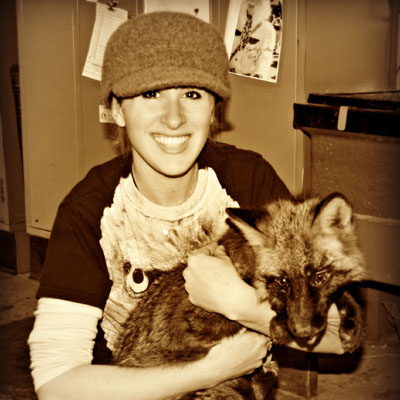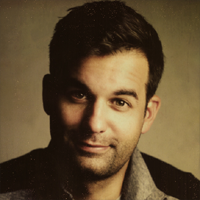
NYCFashionista
New York, NY
Female, 33
I’m the Creative Director/CEO/Jill-of-all-trades at my very own cold-weather fashion accessory business. I design and market a line of knit-based fashion accessories (scarves, gloves, hats) aimed at the contemporary market. My work can be found in several specialty boutiques in the US and Asia.
Finding more time to design and create. As this is only my second season, I spend almost 80% of my time focusing on sales and building distribution.
The fashion community is small - high-priced wardrobes usually come free or at a steep discount from other friends in the industry. If you like clothes, working in the fashion industry has its perks!
Precisely because it's so easy to set up online store fronts, many more independent designers are showing and selling their work online. It's become exceedingly difficult to cut through the clutter. In this environment, consumers are relying more on retailers to assume a curatorial or "tastemaker" role to make sense of all the stuff that's out there. Some good examples are Opening Ceremony and Tenoversix. An emerging designer would typically need their help in establishing a following for their line or label. Having said that, it's totally doable for a new designer to build their own distribution, but it would typically involve a big financial investment and a brick-and-mortar retail presence. Tory Burch and the t-shirt brand Johnny Cupcakes built their businesses this way.
I design a line of knitted accessories with a contemporary, "design-forward" aesthetic -- think your funky high school art teacher who suddenly has a corporate job and needs something sophisticated she can wear everyday while still expressing her flair and individuality. My designs rely on graphic patterns and stitches, so designing on a small scale with accessories allows me to work in more experimental concepts in my designs -- can't say I'd be able to do the same thing with apparel. I also like working with knits because of the instant gratification involved in creating your own fabric and patterns. I get to experiment and see the results in real-time. For someone who's a control freak like me, it's a great medium to work with.
Zookeeper and Animal Trainer
 Are a lot of people in your line of work vegetarian/vegan?
Are a lot of people in your line of work vegetarian/vegan?
Flight Attendant
 What's the scariest flight you've ever been on?
What's the scariest flight you've ever been on?
Stand-Up Comedian
 What types of crowds are the worst for you to to perform for?
What types of crowds are the worst for you to to perform for?
Pay-scale varies widely depending on employment circumstances. Anywhere from $70,000 a year for a competent freelancer in a major metro area to $300,000 for a creative director position at a mainstream fashion label. Expect $0 if you're in the first year of launching your own fashion business.
I had a black knitted cap from my FW12 collection that was a big hit in the Orthodox Jewish community! Two women who ran a retail operation from their apartment in Brooklyn saw my collection at a trade show and placed an order of 200 black hats! You never know where the next sale is coming from...
They can be your best friend if you invest in building a business relationship and deal with each other in a respectful, considerate manner.
Find a way to get your idea produced in small batches to test market demand and production feasibility for your concept. So get samples made pronto! Get on craigslist or ask your friends for references for tailors, silk-screen print shops anything you need to understand what goes into making the product... The goal here shouldn't be perfection but to get feedback fast, so you can adjust, refine, sell, and get more feedback - repeat! However, if you have access to a factory, I highly recommend working with them as early as possible. You can come up with an amazing prototype but if it can't be practically produced en masse that won't work either. People focus so much on testing market demand but the prototyping process is also a great opportunity to get insight into the production feasibility of your concept. But between the two, it's easier and better to focus on market demand first. You can always scramble when the sales orders come in!
Did it ever really come back? Actually I think it's just about to make a big comeback - that along with tapered jeans... yes, the same pair you wore in high school...
The harsh glare of reality TV is not for me. I'd probably consider it only if I had a way to generate sales and / or capitalize on the publicity. If my business were up and running, maybe... But if you're going to do it - make sure you have a web presence at the very least! Opportunities will come if people know how to get in touch with you...
Last season, I created a line of reversible "hoodscarves" (really a hat with long lapels that double as a scarf). It was functional, versatile and practical, why wouldn't it sell?! Each and every buyer liked the item but complained about the item's "hanger appeal." "Hanger appeal" is important to buyers. If your design won't look good on a clothes rack or shelf, or if it requires a special display or a long-winded explanation from the salesperson to move -- it won't sell. Apparently my hoodscarf concept fell into that category.
Fashion shows were created with fashion buyers in mind. In a few minutes, fashion buyers can review the designer's best looks and place orders that will arrive 6 months later. But the clothes/looks you see on the runway are just samples. Once buyers place their orders after the show, only then would a *smart* designer line up manufacturing / fulfillment. So it's also a great way to test concepts and measure consumer demand before locking cash in production. As many as 70% of the looks shown are typically not picked up, but the 30% that do make it are usually the most commercial pieces that will go on to sell well. Competition is fierce during fashion week and it's important to stand out. Therefore many designers add "extreme" designs / looks to the mix - these are not commercial pieces but play an important role in communicating the designer's perspective that season. Stores all follow a pretty set buying calendar and place their biggest orders for fall and spring. Designers cater to these buyers so fashion shows take place during "market" week in the major fashion cities such as New York, Paris and Milan, when buyers flock to these cities looking for items to sell in their stores 6 months later. These shows attract media attention b/c people want to know what they should be wearing in 6 months! Not surprisingly, fashion show commentary and photos sell -- "fashion issues" are typically one of the most lucrative issues in a magazine's/newspapers editorial calendar.
American Apparel made a very conscious business decision to keep manufacturing in the US because it pays, period. Consumers were clamoring for US-made garments and were willing to pay a premium for it. Producing everything in their own vertically-integrated factory in the US costs way more than outsourcing, but American Apparel can respond to market demand quickly and avoid stock-piling inventory in their stores. Aside from the business rationale, US-based production also happens to make for a good brand story.
I think fashion school is useful insofar as it gives budding designers a head start in the industry -- production techniques, industry contacts, business practices, nomenclature -- they teach you all that in fashion school. But anyone with boundless confidence and a thick skin can break into this industry and succeed. Having said that, a period of paying dues is expected even for graduates of fashion programs. Apprenticeships at successful fashion companies would probably be more crucial to success in the industry -- people learn more by doing. Also buyers, especially at the big department stores, like to see professional pedigree and rarely back new, unproven designers. They need to be confident that you can deliver merchandise and that it will sell.
If you're looking to build your resume by apprenticing with a top designer, the good news is that yes, you can avoid New York! You can build your career in London, Los Angeles, Paris, and Milan as these are also major centers of fashion in the world. But if apprenticing is not your cup of tea, you can work remotely out of virtually any location as long as you have dependable Internet connection to sell your designs and PR skills to promote your line to anyone who will listen.
It irks me that the commodification of labor and materials have caused people to devalue the intangibles - design skills, materials innovation and creativity. These skills cost money to develop and nurture in a fashion company -- only makes sense to reward designers/fashion companies for it! Having said that, the fashion industry with its short, fast-paced sales/design cycles somewhat forces designers to copy and capitalize on trends. It's a more complicated issue with no easy answers.
Unless a brand owns its own manufacturing facility, it's a difficult and expensive strategy to implement. Manufacturers live and die by volume. Mainstream brands who have this service (e.g. Nike) typically treat it as a fringe project/business aimed at brand loyalists and for buzz. They can engage in this sort of business because their ready-to-wear business pays the bills. Niche bag company Freitag also has a custom business, but I have a feeling their ready-to-wear business props that up as well. I have yet to see a mainstream company that is built entirely on the premise of customization.
Have not yet tried pinterest but did hear that the interface was great and a delight to use. Visuals can be so much more evocative than words can ever be so Im grateful theres a program out there that helps me better express, share and communicate my ideas. The fashion industry is all over it because much like polyvore designers and buyers can freely pick up on trends that will translate to more sales in stores.
Can't really speak to whether people are getting bigger but clothing sizes has become a ad hoc / relative measurement and should be thought of primarily as tool fashion companies use to sell more clothing and nothing more. If anything, clothing sizes have been dropping and you can see why that makes sense- let's say you're typically a size 8, you walk into a store and happily discover that you're now fitting into a size 6 - you feel good and more likely than not, you will end up purchasing the garment. This is an industry phenomenon called vanity sizing. Tim Gunn of Project Runway/Parsons-fame had harsh things to say about this: http://www.mamapop.com/2011/09/tim-gunn-blasts-deceptive-shell-game-of-vanity-sizing.html To be sure, fashion schools do teach students what the standard sizes are -- not sure who came up with the standards -- but these measurements are pretty dated and were probably developed using a homogeneous population that's no longer relevant to our new multi-cultural, global fashion market.
Impact" can mean a couple of things. Sales can get a strong lift if popular, relevant, and aspirational celebrities wear certain market-ready, in-store styles: Kate Middleton, Michelle Obama, and (ulp) Kim Kardashian. The dress Kate Middleton posed in for her engagement photos 2 years ago continues to be reissued by Reiss 4 seasons later! Impact can also mean setting the course for a trend to bubble up in a couple of years. Gaga's outfits are definitely not market ready but her penchant for over-the-top crystals is slowly making it's way into styles for next fall, to give one example. But I can't really think of one celebrity pulling the shots in the fashion world today - that tells you something about how fragmented and niche-driven the fashion business has become!
At the last Market Week, I showed infinity scarves that featured bright, almost saccharine-neon, colorways. Some of my color choices were risky, but I made sure to merchandise those with more commercial, "safer" colorways. I think buyers appreciate that kind of restraint and commercial sensibility. Anthropologie just picked up the line for the fall.
I'd say 90% of perceived fashion problems are fit-related -- either something is too big, too small, doesn't hug certain parts of the body right, etc. Also garment length - having a skirt fall 1" above or below the knees makes a big difference to the look of the outfit and the wearer. So I'd start with the skirt length -- for shorter people, I would keep the skirt length above the knee. If that doesn't work, check the chest area, should be smooth and shoulders should look well tailored. If that doesn't work, you might have a larger design-related issue at hand ;)
Fashion models display a neutral "face" so buyers focus on what they're wearing not how they look.
4 years ago, spurred by a crap job and a need to have a more flexible work schedule. Looking back, my decision was more of a lifestyle play vs the culmination of a lifelong goal.
I don't think it's a requirement. But you should know a good seamstress to execute your designs/samples for sure! As long as you know how to give clear instructions, and can communicate exactly what you want, you should be outsourcing that function and spending your newfound time getting to know your customers/market and coming up with better designs.
A need to create and a love of beautiful things...
I personally think not. I think that unfortunate stereotype is largely shaped by the media looking for an interesting subject -- unfortunately, dueling designers, outrageous designs, and out-sized personalities in our industry make more interesting subjects!
Listening to your customers, reflecting on mistakes, and being able to be flexible and willing to deviate from a set strategy have helped me a lot in this business. I try to avoid being overly confident - that attitude's gotten me nowhere in the past. It's getting harder to predict what the market wants.
For a junior designer / design assistant, they look for the right work attitude - wilingness to work hard and do grunt work (fashion is hardly glamorous!), detail orientedness and overall dependability. For more senior designers, brands generally look for a commercial sensibility and merchandising skills.
Yes - I'm ADD and that's helped fuel design ideas that can come from anywhere.
I have equipment that I use for my designs - hand knitting kit (needles and yarn) and flat knit machine. I work from home.
Clothes look better on tall, lean silhouettes - this physique sells outfits best!
Don't put so much pressure on yourself to develop an original or unique look or perspective as a designer for your line. There are no "originals" in fashion just people really good at referencing and reinterpreting design ideas and trends. That realization has helped me take risks and put more of myself out there with quite good results.
Favorite - the rush I feel when buyers I admire respond well to my designs; hates - handling samples and trying to get rid of them after season.
You need to talk to a stylist.
-OR-
 Login with Facebook
Login with Facebook (max 20 characters - letters, numbers, and underscores only. Note that your username is private, and you have the option to choose an alias when asking questions or hosting a Q&A.)
(A valid e-mail address is required. Your e-mail will not be shared with anyone.)
(min 5 characters)
By checking this box, you acknowledge that you have read and agree to Jobstr.com’s Terms and Privacy Policy.
-OR-
 Register with Facebook
Register with Facebook(Don't worry: you'll be able to choose an alias when asking questions or hosting a Q&A.)